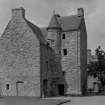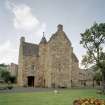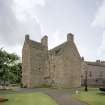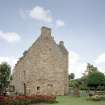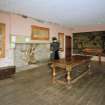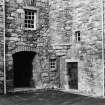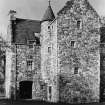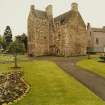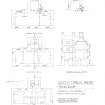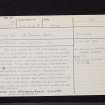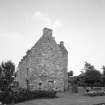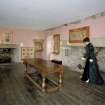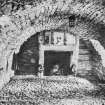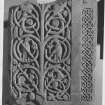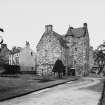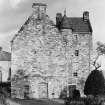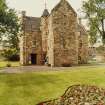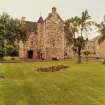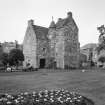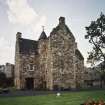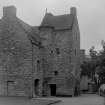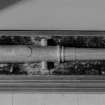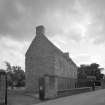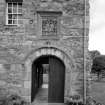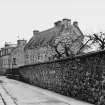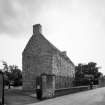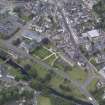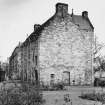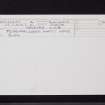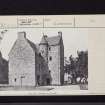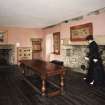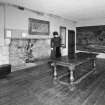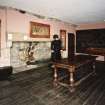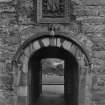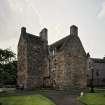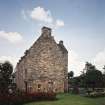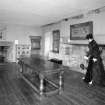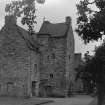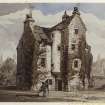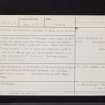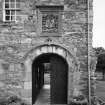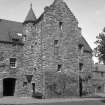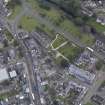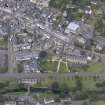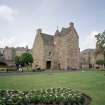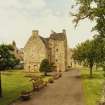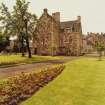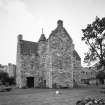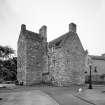Jedburgh, Queen Street, Queen Mary's House
Bastle (Medieval)
Site Name Jedburgh, Queen Street, Queen Mary's House
Classification Bastle (Medieval)
Alternative Name(s) Jedburgh Museum
Canmore ID 57038
Site Number NT62SE 29
NGR NT 65162 20674
Datum OSGB36 - NGR
Permalink http://canmore.org.uk/site/57038
- Council Scottish Borders, The
- Parish Jedburgh
- Former Region Borders
- Former District Roxburgh
- Former County Roxburghshire
Jedburgh 4 (Hartrigge), base of cross-shaft
Measurements: H 1.45m, W 0.99m at the base and 0.54m at the top, D 0.71m at the base and 0.43m at the top
Stone type: sandstone
Present location: in the grounds of Mary Queen of Scots House, Jedburgh, to the east of the house.
Evidence for discovery: in 1834, the stone stood at the south end of Old Bongate on the east bank of the Jed Water (NSA 1845, 12). The Ordnance Survey town map of Jedburgh of 1858 marks the location on the south-east side of Bongate as ‘Site of Runic Altar’. Alexander Jeffrey recorded, however, that the four holes in face B were ‘cut by some Goth to place the crooks of a toll-bar gate, the stone having at one time been used as a post of the gate to the turnpike’ (in Smith 1874, 453), which implies that the OS site may not have been its original location. Its adoption for the turnpike would have been in the later eighteenth century. From Bongate it was moved first to the Market Place at the top of the Canongate, where it proved a nuisance to coal carts, and thence in the 1850s to the grounds of Hartrigge House to the north-east of the town (Canmore 144598). Around 1960 it was moved back to Jedburgh to the garden of Mary Queen of Scots House on Queen Street, initially close to the house and, after conservation in 2013, it was placed farther to the east near the garden boundary the following year.
Present condition: very worn and damaged. Face B has extensive damage along its right-hand edge, probably related to coal-cart traffic during its time in the Market Place. Faces B and C show modification probably for use as a gate-post in the form of socket holes on face B and two socket holes and a wide vertical groove on face C. The circular depression in the top may also relate to its use as a gate-post.
Description
This is a trapezoidal block which tapers towards the top. Three roll mouldings encircle the base of the stone, giving the visual impression of steps, and each corner has a vertical roll moulding. Traces survive on faces A and D of an inner narrow roll moulding. Above the basal mouldings are panels with zoomorphic and interlace motifs carved in relief, now very worn but originally very complex and detailed. Face A is carved with a bush scroll with a deeply incised central stem running from a chunky base root almost to the top of the stone. It has two pairs of scrolls, the lower pair curving downwards and the upper pair curving upwards. Birds are perched in the upper pair, both facing left but the left-hand bird appears to be looking backwards. The lower scrolls curve around two confronted horses and enmesh their legs.
Face B is badly damaged but there is a clear quadruped on the left and indications of another on the right, making a confronted pair, with their forelegs braced against one another. The head and neck of the left-hand animal, probably a horse, arches backwards and has the end of its tail in its mouth. There is another pair of smaller animals between the first pair, possibly suckling foals.
Face C is very badly damaged but there are traces of a single animal facing left, its legs enmeshed in plant stem. Face D bears two confronted quadrupeds with long legs, their chests almost touching and their heads turned to look back, with elongated tails twisted round their bodies and finishing in their mouths. There are traces above of another pair of quadrupeds, this time nose to nose with arched necks.
The top of the stone, face E, is carved into a large circular and rounded tenon and a circular hollow with a square inset. The tenon is about 50mm high and appears to have been modified by the adjacent hollow.
Date range: ninth century.
Primary references: NSA 1845, 12; Smith 1874, 451-3; ECMS (Jedburgh 4), 435; Cramp 1983, 274-6, fig 117; HES Archive, AOC Archaeology Group, high resolution laser scan survey, 2010.
Research by A Ritchie 2019
NT62SE 29.00 65162 20674
NT62SE 29.01 NT 6516 2067 Perforated Stone
(NT 6516 2067) Queen Mary's House (NR)
OS 25"map, (1921).
This fine example of a late 16th century bastel house is three storeys in height; on plan it includes an oblong main block with a rectangular stair-tower projecting 14 feet eastwards near the centre of its east side. It is clear that another structure was originally attached to its south gable, and there is some evidence to suggest that a tenement has also abutted on the corresponding gable to the north. While it is obvious that 'Queen Mary's House' has been very considerably altered, its plan indicates that it was not built before the last quarter of the 16th century.
It was once the temporary residence of Mary, Queen of Scots. (J Small 1881).
RCAHMS 1956.
After the destruction of Jedburgh Castle (Roxburgh NT19NE 7) in 1409, six houses with the features of the old Border peel towers were built around the town. These were known as 'bastel-houses'. One of these was built in a part of the town known at the time as 'Limmerfield' which is now the site of Queen Mary's House..... The other houses have all disappeared.
J Renilson 1937.
The building is as described and illustrated by RCAHMS 1956. As well as being of historical interest, the building houses a small museum.
Visited by OS(EGC) 7 January 1963.
Non-Guardianship Sites Plan Collection, DC28033- DC28042, 1929- 1930.
Sbc Note
Visibility: This is an upstanding building.
Information from Scottish Borders Council.

























































